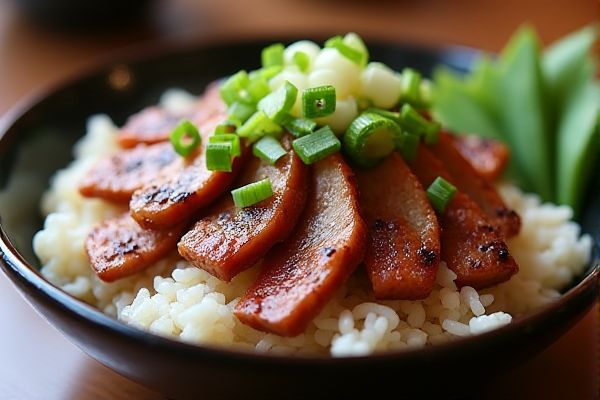
Duck Donburi from Wagamama features tender slices of succulent duck breast served over steamed rice, garnished with fresh scallions and a savory soy-based glaze, delivering a harmonious blend of rich flavors and comforting textures.
Equipments
- Chef's knife
- Cutting board
- Saucepan
- Frying pan or skillet
- Tongs
- Mixing bowl
- Whisk
- Measuring spoons
- Measuring cup
- Rice cooker or saucepan (for rice)
- Serving bowls
- Slicing board
- Spoon (for glazing/garnishing)
Ingredients
- 2 duck breasts
- 2 cups (370g) Japanese short-grain rice
- 4 cups (950ml) water
- 2 tablespoons vegetable oil
- 4 tablespoons soy sauce
- 2 tablespoons mirin
- 2 tablespoons sake
- 1 tablespoon sugar
- 1 tablespoon hoisin sauce
- 2 scallions
- 1 tablespoon toasted sesame seeds
- Salt
- Pepper
Ensure the duck breasts are fresh and trimmed of excess fat for the best texture and flavor in your Duck Donburi. Use Japanese short-grain rice to achieve the authentic sticky, slightly sweet base that complements the rich duck and savory glaze. Balance the soy sauce, mirin, and sake carefully to replicate the distinct umami profile characteristic of Wagamama's dish. Toasted sesame seeds and fresh scallions provide essential garnish elements that enhance both the taste and presentation. Your Duck Donburi from Wagamama copycat menu will deliver an authentic, satisfying meal when these key ingredients are properly prepared.
Instructions
- Rinse the rice under cold water until the water runs clear.
- Cook the rice in a rice cooker or saucepan with 4 cups water.
- Score the skin of the duck breasts in a crosshatch pattern.
- Season the duck breasts generously with salt and pepper.
- Heat a frying pan or skillet over medium heat.
- Add duck breasts skin-side down; cook until skin is crispy and fat is rendered.
- Flip duck breasts and cook until desired doneness.
- Remove duck from pan; let rest on slicing board.
- In a saucepan, whisk together soy sauce, mirin, sake, sugar, and hoisin sauce.
- Bring sauce mixture to a simmer; cook until slightly thickened.
- Slice scallions thinly.
- Slice the rested duck breasts thinly.
- Fluff cooked rice and divide into serving bowls.
- Arrange sliced duck breast over rice.
- Drizzle soy-based glaze over duck and rice.
- Garnish with scallions and toasted sesame seeds.
- Serve immediately.
Substitution
Duck Donburi from Wagamama copycat menu highlights tender duck breast slices paired with steamed Japanese short-grain rice and a savory soy-based glaze. If you cannot find duck breasts, chicken thighs can be a suitable substitute, offering a similar texture and flavor profile. When mirin or sake are unavailable, a mixture of dry sherry and a small dash of sugar works well as an alternative. Your rice cooker significantly simplifies preparing perfectly steamed rice, but a heavy-bottomed saucepan with a tight-fitting lid can achieve comparable results. Adjust seasoning with salt and pepper based on your taste preference to balance the dish's richness.
Tips
Ensure you score the duck skin carefully with a sharp chef's knife to allow the fat to render properly and crisp up during cooking. Rinse the Japanese short-grain rice thoroughly until the water runs clear to remove excess starch for ideal fluffy texture. Let the duck breasts rest after cooking to retain juicy tenderness when sliced thinly over the rice. Whisk the glaze ingredients well and simmer until slightly thickened to achieve a balance of savory, sweet, and umami flavors in your dish.
Nutritions
Duck Donburi provides a protein-rich meal from tender duck breasts, supplying essential amino acids for muscle repair and growth. The Japanese short-grain rice offers a good source of carbohydrates, fueling your body with sustained energy. Soy sauce and hoisin sauce contribute to sodium intake, so it's important to balance this dish with other low-sodium meals throughout the day. Toasted sesame seeds add healthy fats and a small boost of fiber, enhancing your overall nutrient profile.
Storage
Store any leftover Duck Donburi in an airtight container and refrigerate promptly to maintain freshness, ideally consuming within 2 days. Keep the sauce separate if possible to preserve the texture of your rice and duck when reheating. Reheat gently in a microwave or skillet to avoid overcooking the duck breast and enjoy your meal at its best quality.
Variation or Alternatives
You can substitute duck breasts with chicken thighs for a more economical variation while maintaining rich flavor. Instead of the soy-based glaze, try a miso glaze by mixing white miso paste with mirin and sugar for a slightly sweeter, umami-rich sauce. Roasting the duck in the oven gives a different texture, allowing you to achieve evenly crisp skin without constant pan monitoring. For added texture and freshness, consider topping your donburi with julienned cucumber or pickled ginger alongside scallions.
Allergies
Duck Donburi contains soy sauce and hoisin sauce, both of which include soy, a common allergen that may trigger reactions in sensitive individuals. The sesame seeds used as garnish can also cause allergic responses ranging from mild irritation to anaphylaxis. If you have known allergies to soy or sesame, it's important to avoid this dish or consult with the restaurant before ordering.
Why this recipe?
People enjoy Wagamama's Duck Donburi for its rich, tender duck paired with a perfectly balanced blend of soy, ginger, and garlic flavors that infuse every bite. The dish features a savory miso broth and fresh greens, creating a satisfying harmony of textures and tastes distinctive to Wagamama's style. Making a copycat version at home allows you to capture the authentic, comforting essence of this popular menu item while customizing ingredients to suit your preferences. Your homemade Duck Donburi delivers the same delicious depth of flavor and wholesome ingredients without the restaurant price tag.
